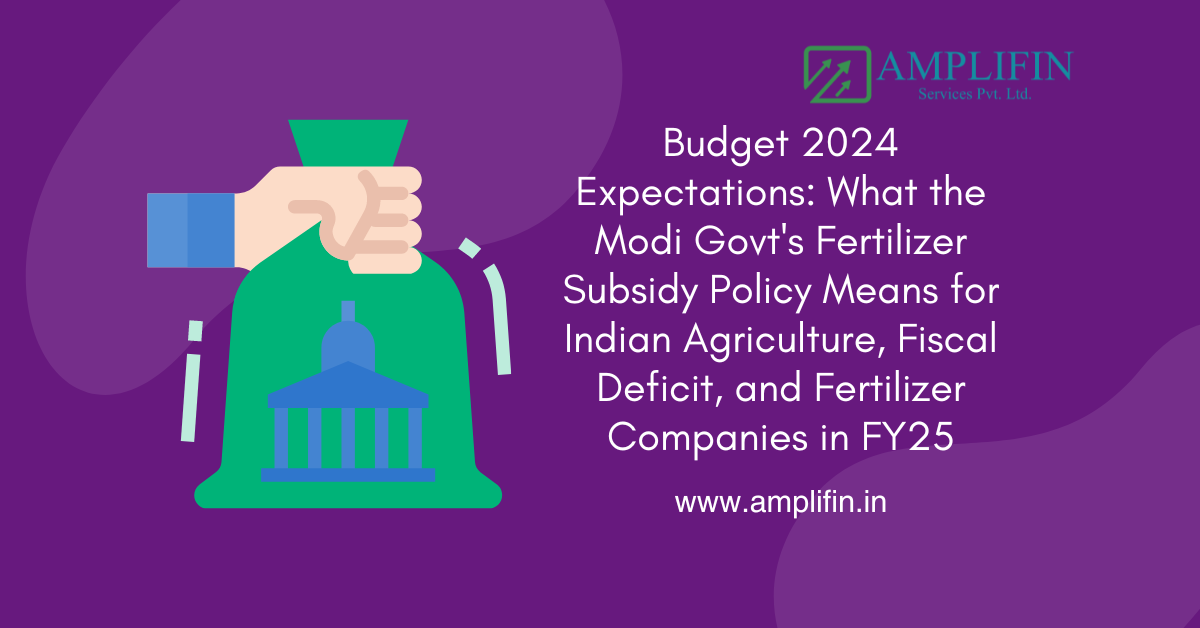Budget 2024 Expectations: What the Modi Govt’s Fertilizer Subsidy Policy Means for Indian Agriculture, Fiscal Deficit, and Fertilizer Companies in FY25
As the Indian government prepares to unveil its Budget 2024, the agricultural sector eagerly awaits news on fertilizer subsidies, particularly under the Pradhan Mantri scheme. This article delves into the expectations, potential changes, and implications for farmers, the fertilizer industry, and the broader economy. Understanding these aspects is crucial for anyone involved in agriculture, policymaking, or investing in the Indian market.

What Are the Key Expectations for Fertilizer Subsidy in Union Budget 2024?
The upcoming Budget 2024 is expected to address several critical aspects of fertilizer subsidies:
1. Subsidy allocation: The government might increase the fertilizer subsidy to support farmers amidst rising input costs, potentially reaching several crore rs.
2. Direct Benefit Transfer (DBT): There could be announcements regarding the expansion or modification of the fertilizer DBT system.
3. Nutrient-Based Subsidy (NBS) scheme: Potential changes to the NBS rates for various fertilizer grades might be introduced.
These expectations stem from the government’s ongoing efforts to balance farmer support with fiscal prudence.
How Will the Fertilizer Subsidy Impact the Fiscal Deficit?
The fertilizer subsidy has been a significant contributor to India’s fiscal deficit in recent years. Budget 2024 will likely aim to:
1. Manage subsidy expenditure while ensuring adequate farmer support.
2. Explore ways to reduce the subsidy burden without compromising agricultural productivity.
3. Balance fertilizer subsidies with other budgetary allocations to maintain fiscal discipline.
The government’s approach to this balancing act in the union budget will be crucial for the overall health of the Indian economy.
What Changes Can We Expect in the Urea Subsidy?
Urea, being the most widely used fertilizer in India, often receives special attention in budget allocations:
1. The government might revise urea subsidy rates to reflect current market conditions.
2. There could be announcements regarding domestic urea production to reduce import dependency.
3. Measures to promote balanced fertilizer use and reduce over-reliance on urea might be introduced in the interim budget.
These changes would aim to optimize urea usage while managing the subsidy burden.
How Will Budget 2024 Address Fertilizer Companies’ Concerns?
The fertilizer industry plays a crucial role in Indian agriculture, and the budget is expected to address some of their key concerns: increasing efficiency and reducing costs by a targeted per cent.
1. Subsidy payment mechanisms: Measures to ensure timely subsidy payments to fertilizer companies might be announced in the context of fy25 planning.
2. Support for domestic production: Incentives for increasing domestic fertilizer production capacity could be introduced.
3. Policy reforms: Changes in regulations affecting fertilizer manufacturing and distribution might be proposed.
These measures would aim to strengthen the Indian fertilizer industry and reduce import dependency.
What Role Will Direct Benefit Transfer Play in Fertilizer Subsidies?
The Direct Benefit Transfer (DBT) system for fertilizer subsidies has been a significant reform in recent years:
1. The budget might announce plans to expand or modify the existing fertilizer DBT system.
2. Measures to improve the efficiency and accuracy of subsidy disbursement through DBT could be introduced.
3. Integration of DBT with other agricultural support schemes might be proposed to create a comprehensive farmer support system.
These changes would aim to ensure that subsidies reach the intended beneficiaries more effectively, aligning with budget 2024 expectations.
How Will Budget 2024 Promote Balanced Fertilizer Use?
Promoting balanced fertilizer use is crucial for sustainable agriculture:
1. The budget might introduce incentives for farmers to adopt balanced fertilizer application practices.
2. Subsidy rates for different fertilizer grades could be adjusted to encourage the use of a wider range of nutrients.
3. Allocations for soil health management programs might be increased to support informed fertilizer use.
These measures would aim to improve soil health and crop yields while optimizing subsidy expenditure, potentially saving the government several lakh crore.
What Can the Agriculture Sector Expect Beyond Fertilizer Subsidies?
While fertilizer subsidies are a crucial component, the budget is likely to address other aspects of agricultural development:
1. Allocations for irrigation infrastructure development might be increased.
2. Support for farm mechanization and technology adoption could be enhanced.
3. Measures to improve agricultural marketing and value chain development might be introduced.
These initiatives would complement fertilizer subsidies in boosting overall agricultural productivity, which is expected to increase by a certain per cent.
How Will Budget 2024 Impact Fertilizer Availability and Prices?
The budget’s provisions will have significant implications for fertilizer availability and pricing:
1. Measures to ensure adequate fertilizer supply during peak seasons might be announced.
2. The impact of subsidy changes on retail fertilizer prices will be closely watched.
3. Initiatives to promote indigenous fertilizer production could affect long-term availability and pricing trends.
These factors will directly impact farmers’ input costs and agricultural productivity.
What Long-term Vision for Fertilizer Policy Can We Expect from Budget 2024?
The budget might provide insights into the government’s long-term vision for fertilizer policy:
1. Plans for gradually reducing fertilizer subsidy dependency might be outlined.
2. Strategies for promoting organic and bio-fertilizers could be emphasized.
3. Roadmap for achieving fertilizer self-sufficiency in India might be presented.
These long-term strategies would aim to make Indian agriculture more sustainable and resilient.
How Will International Fertilizer Markets Influence Budget Decisions?
Global fertilizer markets play a significant role in shaping India’s fertilizer policy:
1. The budget might address strategies to mitigate the impact of international price fluctuations.
2. Measures to secure long-term fertilizer supply agreements with international partners could be announced.
3. Initiatives to enhance India’s position in the global fertilizer trade might be introduced.
These considerations would aim to ensure a stable and affordable fertilizer supply for Indian agriculture.
In conclusion, Budget 2024’s approach to fertilizer subsidies will have far-reaching implications for Indian agriculture, the fertilizer industry, and the broader economy. As we await the budget announcement, it’s crucial to consider these various aspects and their potential impacts.
Key points to remember:
– Fertilizer subsidy allocation in Budget 2024 will balance farmer support with fiscal prudence
– Changes in urea subsidy and promotion of balanced fertilizer use are expected
– The Direct Benefit Transfer system for fertilizer subsidies may see further refinement in the upcoming budget 2024 live updates.
– The budget may address concerns of fertilizer companies and promote domestic production
– Long-term vision for sustainable fertilizer use and reduced subsidy dependency might be outlined
– Global fertilizer market trends will influence budget decisions
– The budget is likely to present a holistic approach to agricultural development beyond fertilizer subsidies
